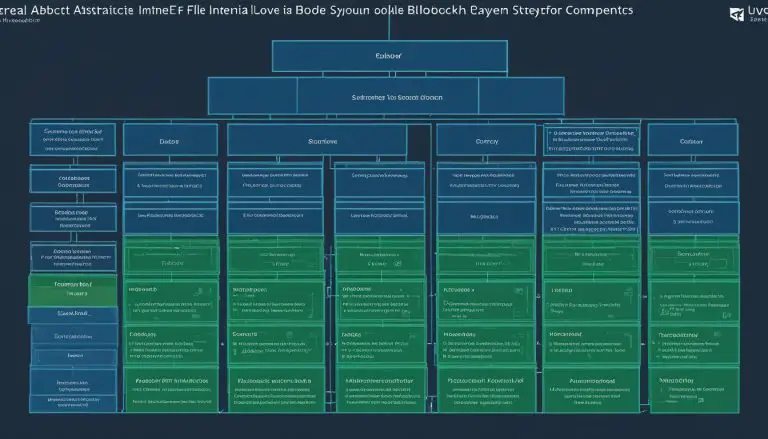Understanding What Does NFS (Network File System) Mean
NFS (Network File System) is a widely used networking protocol that facilitates distributed file sharing across a network. It enables system administrators to share file systems on a networked server, making them accessible to remote computer users.
NFS uses Remote Procedure Calls (RPCs) to route requests between clients and servers, allowing for seamless communication and efficient file management. It is available for most modern operating systems and can share various devices, including hard disks, solid-state drives, tape drives, printers, and peripherals.
This application layer protocol operates over any transport or network protocol stack, although it is commonly implemented on systems running the TCP/IP protocol suite. Over the years, NFS has evolved and introduced versions such as NFSv2, NFSv3, NFSv4, and NFSv4.1, each offering improved performance, security, and additional features.
However, it is essential to consider some drawbacks of NFS. On untrusted networks, there may be security concerns, and the protocol chattiness aspect of NFS can result in overhead and performance issues.
Despite these drawbacks, NFS remains a mature and cost-effective solution for network file sharing. It simplifies centralized file management and allows users to access remote files as if they were local. Now that we have covered the basics, let’s dive deeper into the world of NFS.
Key Takeaways:
- NFS is a widely used networking protocol for distributed file sharing.
- It enables system administrators to share file systems on a networked server.
- NFS uses Remote Procedure Calls (RPCs) to route requests between clients and servers.
- It supports various devices like hard disks, solid-state drives, tape drives, printers, and peripherals.
- NFS has evolved over time, with versions like NFSv2, NFSv3, NFSv4, and NFSv4.1 offering improved performance, security, and features.
The Basics of NFS
NFS allows system administrators to share file systems on a networked server, making them accessible to remote computer users. This networking protocol revolutionizes the way files are shared and managed across a network, simplifying centralized file management. With NFS, files residing on a server can be accessed and manipulated by authorized users from any connected device, as if they were stored locally.
One of the key functionalities of NFS is its ability to enable efficient file sharing. By sharing file systems on a networked server, NFS eliminates the need for file replication or manual file transfers, reducing redundancy and enabling real-time collaboration. This means that multiple users can concurrently access and modify the same file, promoting seamless teamwork and enhancing productivity.
In addition to file sharing, NFS also provides a comprehensive file system management solution. System administrators have the flexibility to manage file systems remotely, granting or restricting access to different users or groups. This ensures secure and controlled file sharing, allowing organizations to safeguard sensitive data and maintain data integrity.
Core Benefits of NFS:
- Efficient file sharing across a networked server
- Real-time collaboration and concurrent file access
- Remote file system management and access control
- Streamlined centralized file management
- Seamless integration with various devices and operating systems
With its extensive capabilities and compatibility, NFS has become a widely adopted networking protocol in the world of technology. It supports various devices, including hard disks, solid-state drives, tape drives, printers, and peripherals, making it versatile for different work environments. Moreover, NFS operates over any transport or network protocol stack, although it is commonly implemented on systems running the TCP/IP protocol suite, ensuring widespread connectivity and ease of use.
As technology advances, NFS continues to evolve to meet the changing needs of users. The NFS protocol has gone through multiple iterations, with each version bringing improvements in performance, security, and additional features. From the early NFSv2 and NFSv3 to the more recent NFSv4 and NFSv4.1, each release builds upon the strengths of its predecessor, enhancing the overall user experience.
While NFS offers numerous advantages, it is important to be aware of some potential drawbacks. NFS may pose security concerns when used on untrusted networks, as unauthorized access to files can occur if proper security measures are not in place. Additionally, the protocol chattiness of NFS, which involves frequent communication between clients and servers, can result in overhead and performance issues in certain scenarios. However, with careful configuration and implementation, these challenges can be mitigated, making NFS a reliable and cost-effective solution for network file sharing.
| NFS Versions | Key Features |
|---|---|
| NFSv2 | Basic file sharing and remote file access |
| NFSv3 | Improved performance and support for 64-bit file sizes |
| NFSv4 | Enhanced security, access control, and file locking mechanisms |
| NFSv4.1 | Parallel processing, improved caching, and server mirroring |
In conclusion, NFS is a powerful and efficient network file system that transforms the way files are shared and managed. By enabling seamless file access and collaboration across a networked server, NFS simplifies centralized file management and promotes real-time productivity. As the protocol continues to evolve, NFS remains a reliable solution for organizations seeking secure and efficient network file sharing. With its widespread compatibility and extensive features, NFS offers a cost-effective and flexible solution for the modern workplace.
How NFS Works
NFS uses Remote Procedure Calls (RPCs) to facilitate communication between clients and servers, enabling the sharing and accessing of files over a network. When a client wants to access a file on an NFS server, it sends an RPC request to the server using the NFS protocol. This request includes information about the file to be accessed or modified.
Once the server receives the RPC request, it processes the request and sends a response back to the client. This response contains the requested file or the result of the operation requested by the client. The RPC mechanism allows clients and servers to communicate seamlessly, making it possible to perform file operations on remote systems as if they were local.
One of the key components in the NFS architecture is the NFS server. The server is responsible for hosting the file systems to be shared over the network. It manages client requests, handles file operations, and ensures the security and integrity of the data being accessed. The NFS client, on the other hand, is the software running on the client machine that allows users to access files on the NFS server. It communicates with the server using RPCs and translates the server’s responses into requests that the user’s operating system can understand.
| NFS Server | NFS Client |
|---|---|
| Hosts shared file systems | Accesses files on the server |
| Handles client requests | Communicates with the server |
| Ensures data security and integrity | Translates server responses |
Overall, NFS is a reliable and efficient protocol for network file sharing. It simplifies the centralized management of files and allows users to access remote files as if they were stored locally. By leveraging RPCs, NFS ensures seamless communication between clients and servers, enabling the sharing and accessing of files over a network.
Supported Devices and Compatibility
NFS can share a wide range of devices and is compatible with most modern operating systems, making it a flexible solution for network file sharing. Whether you need to share files stored on hard disks, solid-state drives, tape drives, printers, or other peripherals, NFS can handle the task seamlessly. This versatility allows administrators to centralize file management and provide remote access to various types of data.
When it comes to compatibility, NFS is designed to work with different operating systems, ensuring smooth integration within heterogeneous environments. Whether you are running Windows, macOS, Linux, or UNIX-based systems, NFS can be implemented on these platforms with relative ease. This cross-platform compatibility enables organizations to deploy NFS across their infrastructure regardless of the operating system used.
| Supported Devices | Compatible Operating Systems |
|---|---|
| Hard disks | Windows, macOS, Linux, UNIX |
| Solid-state drives | Windows, macOS, Linux, UNIX |
| Tape drives | Windows, macOS, Linux, UNIX |
| Printers | Windows, macOS, Linux, UNIX |
| Peripherals | Windows, macOS, Linux, UNIX |
As shown in the table above, NFS is compatible with a wide range of devices and operating systems, providing organizations with the flexibility to choose the hardware and software that best suit their needs. Whether you are setting up a small office network or a large enterprise infrastructure, NFS can be a reliable solution for efficient file sharing and management.
Summary
- NFS supports various devices, including hard disks, solid-state drives, tape drives, printers, and peripherals.
- It is compatible with most modern operating systems, such as Windows, macOS, Linux, and UNIX.
- Administrators can centralize file management and provide remote access to shared data across heterogeneous environments.
With its wide device support and broad compatibility, NFS remains a popular choice for network file sharing due to its ability to meet the diverse needs of organizations in today’s interconnected world.
NFS Versions and Evolutions
NFS has evolved through different versions, with NFSv2, NFSv3, NFSv4, and NFSv4.1 offering enhanced performance, security measures, and additional functionalities. Each version of NFS has introduced improvements to meet the evolving needs of network file sharing.
NFSv2 and NFSv3
NFSv2 was the first widely adopted version of NFS. It allowed clients to access remote file systems and perform basic file operations. However, it lacked features such as strong authentication and support for larger file sizes. NFSv3 addressed these limitations by introducing improved security mechanisms, increased file size support, and enhanced data caching. It also brought performance improvements through the use of stateless operations and advancements in the NFS protocol.
NFSv4
NFSv4 introduced significant changes to the NFS protocol. It introduced the concept of a stateful protocol, which allowed clients and servers to maintain session and state information. This enabled features such as file delegation, improved security with the integration of Kerberos authentication, and support for file replication and migration. NFSv4 also introduced an improved locking mechanism and enhanced access control, providing greater flexibility and security for network file sharing.
NFSv4.1
NFSv4.1 built upon the foundation of NFSv4 and introduced additional features and performance enhancements. It introduced parallel data access, allowing clients to retrieve data from multiple servers simultaneously, improving overall performance. It also included features like pNFS (Parallel NFS), which enables parallel access to storage devices, and Session Trunking, which provides increased network throughput by utilizing multiple network paths.
| NFS Version | Main Features |
|---|---|
| NFSv2 | Basic file operations, limited security, and file size support |
| NFSv3 | Enhanced security, increased file size support, improved caching |
| NFSv4 | Stateful protocol, file delegation, improved security with Kerberos, access control enhancements |
| NFSv4.1 | Parallel data access, pNFS, session trunking |
As NFS has evolved and matured, it has become a reliable and widely used solution for network file sharing. The different versions of NFS have addressed the limitations of previous versions and added new features to improve performance, security, and functionality. NFS offers a cost-effective and efficient way to share files across a network, simplifying centralized management and providing users with seamless remote file access.
Advantages and Drawbacks of NFS
NFS brings various advantages, including simplified centralized management and the ability to access remote files as if they were local. By leveraging NFS, system administrators can create a shared file system on a networked server, enabling remote computer users to access and manipulate files seamlessly. This centralized approach streamlines file management, making it easier to organize, update, and control files across multiple devices and locations.
Moreover, NFS allows users to access remote files as if they were stored locally. This means that individuals working on different machines can collaborate on projects without the need for manual file transfers or version control issues. NFS makes file sharing effortless, enhancing productivity and collaboration within organizations.
However, it is important to consider the challenges that NFS presents. The security of NFS on untrusted networks can be a concern. Without proper security measures, unauthorized access to shared files can compromise sensitive data. System administrators must implement appropriate security protocols, such as encryption and access control, to mitigate these risks.
Another potential drawback of NFS is protocol chattiness, which can lead to reduced performance. The frequent back-and-forth communication between clients and servers can introduce overhead and impact the overall efficiency of the network. System administrators should carefully configure NFS settings and consider implementing caching mechanisms to minimize these performance issues.
| Advantages of NFS | Drawbacks of NFS |
|---|---|
| Simplified centralized management | Security risks on untrusted networks |
| Seamless access to remote files | Protocol chattiness affecting performance |
Alternatives to NFS
While NFS is a popular choice for network file sharing, there are alternatives available that may suit specific needs or preferences. These alternatives offer different features and functionalities, allowing users to choose the best fit for their requirements. Let’s explore some of the notable alternatives to NFS:
Samba
Samba is an open-source networking protocol that enables file and print sharing between different operating systems, including Windows, Linux, and macOS. It provides seamless integration with Windows-based networks and supports the Server Message Block (SMB) protocol. Samba allows users to access shared files and printers on a network and offers features like user authentication, access control, and domain integration.
FTP (File Transfer Protocol)
FTP is a standard internet protocol that enables the transfer of files between a client and a server on a computer network. With FTP, users can upload, download, and manage files across a network. It offers a simple and straightforward approach to file sharing and is supported by a wide range of operating systems and applications. While FTP lacks some of the advanced features of NFS, it remains a popular choice, especially for large file transfers.
WebDAV (Web Distributed Authoring and Versioning)
WebDAV is an extension of the HTTP protocol that allows users to collaboratively edit and manage files on remote web servers. It provides a standard way to create, modify, and delete files on a web server, making it an excellent choice for remote file access and collaboration. WebDAV is supported by various operating systems and applications and offers features like file locking, versioning, and access control.
Note: It is important to consider factors such as security, scalability, and compatibility when choosing an alternative to NFS. Each solution has its own strengths and weaknesses, so it is advisable to evaluate the specific requirements and constraints of your network before making a decision.
| Alternative | Key Features |
|---|---|
| Samba | Windows integration, user authentication, access control |
| FTP | Simple file transfer, wide compatibility |
| WebDAV | Remote file access, collaboration, versioning |
Conclusion
In conclusion, NFS is a mature and cost-effective solution for network file sharing that simplifies centralized management and allows users to access remote files as if they were local.
The Network File System (NFS) is a networking protocol for distributed file sharing, enabling system administrators to share file systems on a networked server, making them accessible to remote computer users. By utilizing Remote Procedure Calls (RPCs), NFS efficiently routes requests between clients and servers, ensuring seamless file access and management across the network.
NFS is widely supported and available for most modern operating systems, making it a versatile choice for organizations of all sizes. It enables the sharing of various devices, including hard disks, solid-state drives, tape drives, printers, and peripherals, further enhancing its practicality in diverse environments.
Over time, NFS has evolved with versions such as NFSv2, NFSv3, NFSv4, and NFSv4.1, each introducing significant enhancements in performance, security, and additional features. However, it is important to be aware of some drawbacks associated with NFS, such as potential security concerns when operating on untrusted networks and the possibility of protocol chattiness, which can impact performance and efficiency.
Despite these drawbacks, NFS remains a popular and reliable choice for network file sharing, offering centralized management capabilities and seamless remote file access. It provides a trusted and efficient means of sharing files across a network, simplifying workflows and enhancing collaboration for organizations in various industries.
FAQ
What does NFS stand for?
NFS stands for Network File System.
What is the purpose of NFS?
NFS enables distributed file sharing by allowing system administrators to share file systems on a networked server and making them accessible to remote computer users.
How does NFS work?
NFS uses Remote Procedure Calls (RPCs) to route requests between clients and servers, facilitating the sharing of files across a network.
What devices can NFS share?
NFS can share various devices, including hard disks, solid-state drives, tape drives, printers, and peripherals.
Which operating systems are compatible with NFS?
NFS is available for most modern operating systems, making it widely compatible across different platforms.
What are the different versions of NFS?
NFS has evolved over time, with versions such as NFSv2, NFSv3, NFSv4, and NFSv4.1 offering improved performance, security, and features.
What are the advantages of NFS?
NFS simplifies centralized management, allowing for easy file sharing and remote access as if the files were local.
What are the drawbacks of NFS?
Some drawbacks of NFS include security concerns when used on untrusted networks and protocol chattiness, which can result in overhead and performance issues.
Are there any alternatives to NFS for network file sharing?
Yes, there are alternative solutions available that serve similar purposes to NFS. These include other protocols or technologies for network file sharing.
- About the Author
- Latest Posts
Mark is a senior content editor at Text-Center.com and has more than 20 years of experience with linux and windows operating systems. He also writes for Biteno.com






